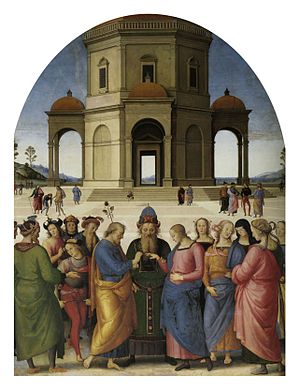Marriage of the Virgin (Perugino)

|
| The Marriage of the Virgin |
|---|
| Perugino , 1501-1504 |
| oil on wood |
| 234 × 186 cm |
| Musée des Beaux-Arts de Caen , Caen |
The Marriage of the Virgin is an oil painting on wood (234 × 186 cm) by the painter Perugino , dated 1501–1504 and is in the Musée des Beaux-Arts in Caen , France . It shows the marriage of Mary to Joseph .
history
The work was originally painted for the Chapel of the Holy Ring in Perugia Cathedral , where the relic of the Virgin's wedding ring is kept. The chapel, completed in 1489, was redecorated after the relic was recovered in 1488 after it was stolen from a church in Chiusi .
The large altarpiece, originally commissioned from Pinturicchio , was entrusted to Perugino, who worked there from 1501 to 1504. During the French occupation of Italy, the painting was confiscated by Napoleon in 1797 and given to his uncle Cardinal Joseph Fesch . Its collections were partly acquired in 1845 by the bookseller Bernard Mancel from Caen, who handed them over to the Musée des Beaux-Arts de Caen in 1872, which was then headed by the painter Alfred Guillard . Every attempt by the municipality of Perugia to get the work back failed.
Description and style
The composition of the painting is reminiscent of the handing over of the keys , which Perugino painted as a fresco in the Sistine Chapel about twenty years earlier : In the background there is a large octagonal building with a central floor plan (symbol of the Jerusalem Temple ) on a base with perspective plates. The scene in the foreground is reinforced according to an ideal of geometric rationality that has become one of the symbols of the Italian Renaissance, especially after it was also used by Raphael in the famous Marriage of Mary from the Pinacoteca di Brera (1504).
The building is at the end of a staircase and has a Renaissance column portal with a round arch, a dome and probably a portal with an identical triangular tympanum on each of the four main sides . The blind arch motif can also be found on the smaller pages. Above the cornice, the second floor has a decorative frame with pilasters , markings and cornices in which there are rectangular windows with arched tympana. The dome with a balustraded path is made of bricks, the upper edge of which has been cut off, making it look even more imposing than it actually is. It is a building that recalls the classical ideal of the Renaissance, as it was imagined by the intellectuals of the time from Leon Battista Alberti's treatises: in reality, buildings were never furnished with such elements in Roman architecture .
As in most of Perugino's works, the composition is based on symmetrical criteria that are animated by the rhythmic variation of the poses. Around the central center of the priest, who stands perfectly on the axis of the central building and in front of the majestic door that is open in the background, Saint Joseph , dressed in yellow on the left, with male companions, and the Virgin Mary, on the right, followed by the women, are gathered. According to the tales of Mary, as soon as she had finished her monastery in the Jerusalem temple, where she had spent all her youth, she was destined for the wedding, but only with the one whose staff had been chosen with a divine mark. Joseph's walking stick blossomed, but that of the other young men did not. In the episode's iconography , you always see at least one of them breaking his own stick with his leg or knee. The apparently old age of Joseph was one element that highlighted the impossibility of marriage, thereby implying the dogma of the virginity of Mary .
The fabrics fall heavy and bright like stains of color, with a “wet effect” that Perugino learned in Verrocchio's workshop during his training in Florence . The landscape in the background shows rolling hills lined with slender trees that fade into the distance towards the horizon and give the impression of an infinitely wide and deep space.
Others
The representation is very similar to the Marriage of the Virgin by Raphael from 1504. The picture is considered Raphael's first masterpiece, with which he surpassed his teacher Perugino. The painting by Perugino was ahead of this and probably the model.
literature
- Vittoria Garibaldi: Perugino . In: Pittori del Rinascimento . Scala, Florence 2004, ISBN 88-8117-099-X .
Web links
Individual evidence
- ↑ Marriage of Mary 1504 - Raffael , Wikiart, accessed on January 22, 2019.